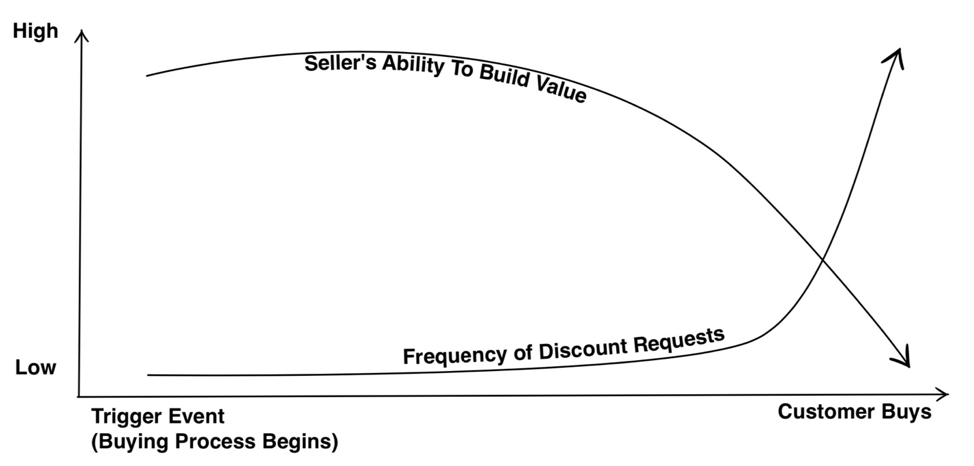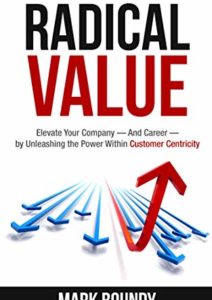Six Ways to Commit “Suicide by Discount”
It’s often tempting to discount your way out of sales trouble, but sometimes you’re doing more harm than good. While discounting is sometimes necessary, it’s often the biggest mistake you can make. How do you know which situation is which?
Full disclosure here: I’m highly biased against discounting. My regular readers know that I’m a pricing hawk, and my clients engage me because of it. Within the Miller Heiman Group network, value-based pricing was my differentiating characteristic. I’ve managed too many P&Ls to be comfortable with knee-jerk discounting behaviors I often see.
Just because discounting throws away profit dollars, is that any reason to call it suicidal? Maybe. Maybe not. There are sometimes good reasons to discount, but dropping your price damages more than this month’s/quarter’s/year’s financials. First, the pain of discount-trained customers lasts far beyond today’s closed deal celebration. Or, as mom used to say: “Just because you can, doesn’t mean you should”. Second, and even more important, price declares value — discounting price declares belief of diminished value. If the seller doesn’t think it’s worth the original price, should the buyer?
So, what are the signals that discounting is simply a crutch for poor selling and/or marketing? Here’s a checklist:
The Value is Already High Enough
Many customers push back on price, no matter how satisfactory. For instance, sales professionals operating in Latin America tell me that aggressive price negotiation is standard business culture there. These negotiators aren’t looking for any particular number, they’re just looking for capitulation…connected with any number. Convince them that there’s no money left on the table for them to win, and they’re done.
Another approach is to walk them through the value justification you’ve been building all through the discovery and proposal-building process. You know, the value you validated with every persona. Your process does build a value case using the customer’s own monetary estimates, right? You have a sales methodology which helps sellers build that value calculation in detail…you have one of those, right?
If not, consider the value of adopting one. How many discount dollars (remember, discount dollars = profit dollars) did you issue to customers last year? Compare that amount to the cost of upgrading your current methodology to capture those profit dollars. How many more digits in the first number? So…Should we talk?
You Don’t Know Your Value
If your salespeople can’t validate value monetarily with a customer, they aren’t equipped to have any price discussion. When they are thus disadvantaged, of course, they’ll want to discount their way out of trouble. This outcome is only minimally the sales person’s fault. Leadership holds majority responsibility in providing tools to prevent it, setting their teams up for failure.
I once worked for a company whose culture practiced “if Sales can’t articulate value, Product can’t discuss pricing”. This company had enshrined value-based pricing as a pillar of the company culture. Nothing moved for an opportunity until everyone knew what value the customer perceived from our offer. Nothing stood in our way once the value was known–and high enough.
In contrast, I also worked with a company in the middle of a sales force turnover. The outgoing sales force was known for building value and never discounting. Clients routinely recouped their entire investment in 2-6 months (remember, six months represents a 200% 1st year ROI). Once prospects anticipate such results for themselves, price becomes unimportant. The incoming replacement salespeople and weren’t equipped to articulate and validate value with customers. As a result, neither the buyer nor seller knew the value of the offer. Discounting became rampant and steep, and EBIDTA shrank to “shameful”.
You’ve Sold Too Narrowly
Has your sales strategy engaged all affected personas? Chances are that they have not. Even sales methodologies who teach engaging “all” personas, ignore out-of-normal-scope “optional” personas–who could yield additional value. We intuitively shun the decision complexity of adding personas, without strategically adding personas who are natural allies. Sometimes adding people amounts to “packing the court in your favor”.
I regularly engage with clients who engage too narrowly. Customers build a group buying decision dynamic around the organizational silo/department who has a budget. Too often, salespeople follow this definition of “buying team”, ignoring all of the other silos who benefit from their offer. Business acumen would guide sellers to expand the buying ecosystem advantageously.
If a sales strategy hasn’t built value broadly in a prospect organization, there may not be enough value to support the desired pricing. Look at it another way. Your company invested resources in producing customer value, but your sales approach failed to leverage all available value into pricing. If you can’t charge for the value you produce, how sustainable is your business?
You’ve Sold Too Shallowly
Building some value with a buying persona is good. Building more value is better. I have yet to encounter a methodology that doesn’t allow sellers to add more value drivers into the mix. I have also yet to encounter a methodology (or a product training program, for that matter) that equips salespeople with all of the value drivers possible.
Your sellers are capable of selling more value to existing personas. I find they are often missing some combination of business acumen, value-focused product training, and/or selling tools to sell full value. Without your sales people’s help, your customer can’t build full value in their own mind, and the internal price/value math doesn’t check out. They might think “the value is too low”, but say “your price is too high”. Those two are the same thing, but many salespeople respond with price concessions.
You Started Building Value Too Late
Customers sense that last-minute value-building is simply an effort to resist discounting and don’t play along. However, a sales professional can build value relatively easy early in a customer’s buying process.
Discounting pressure, however, occurs mostly late in a customer’s buying cycle. This is when it’s too late to build value in a prospect’s mind

Do your value selling work ahead of the discounting curve.
The Value is Too Low Because You’ve Crippled Your Offer.
I once had a client who would pare down first opportunities into new clients. The idea was to win a low-risk first engagement, then grow from proven results. This is the familiar “land and expand” strategy. Unfortunately, these first engagements were so narrowed that compelling results were almost impossible to achieve.
Designing the value out of an offer to make it easier to swallow traps the seller into discounting a low-value offer. Worse, it establishes low value for all future “expand” opportunities. This could easily be “suicide by discounting”.
If your business involves follow-on sales, discounting the entry offer is extremely dangerous; you need a convincing “trial basis, then full price” story. You also need the initial offer to prove “full price value”; think “full value delivery at small scale”, not “low sticker price”. Predefined criteria for success should also be part of the equation; force a customer to measure value.
The Road to Failure is Paved with Discounted Sales.
I love building profitable businesses. Not opportunistic gouging profits, but real, win-win, value-based profits. I love helping clients do the same thing.
Please share if you liked this article…or comment…or like. Contact me if you’d like to discuss in more detail.
To your success!
I help executive teams uncover the causes of excessive discounting. Here are a few of the big runners.






Comments (1)
The right discounting is a major challenge because clients as well consider the relationship of the discount to the price. Just as the pricing has to be perfect fit, also the discount has to be perfect fit. To know what is perfect fit is an equilibrium that shows that the discount is neither too low for the customer to have doubt and to high for the client to suspect it’s worth to the organization. Discounting is an art and it is a very salient key in paving way for a successful closure of a deal.